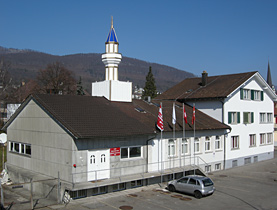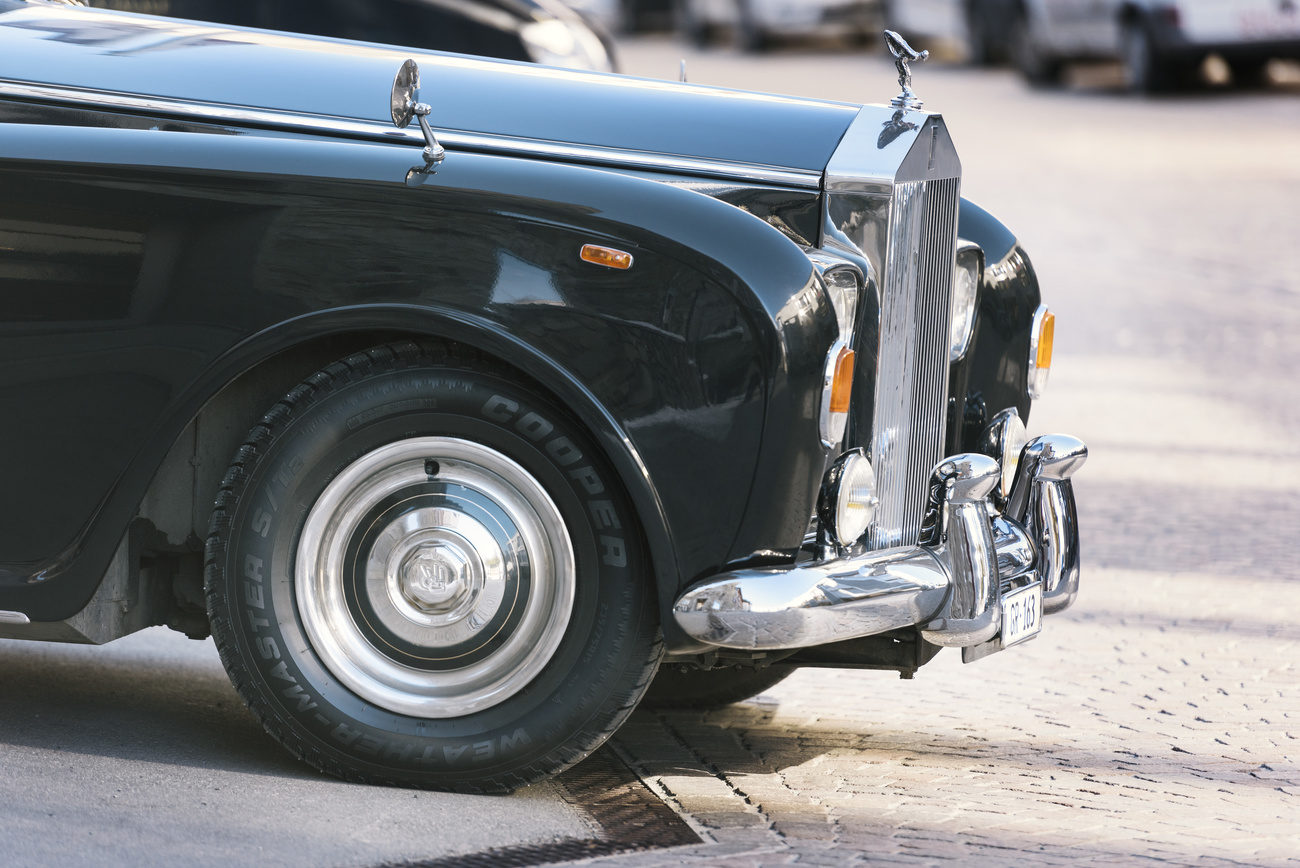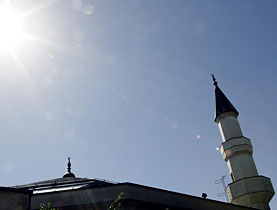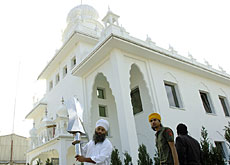Deconstructing the new religious landscape

Experts have been studying why it is easier for some non-native religions to build a temple or church in Switzerland, whereas others, such as Muslims, face resistance.
Lucerne University researchers examined the complex issue of new religious buildings and their symbols in the public domain, and the possible tensions that can arise from this. Their results form the basis of a special exhibition.
“Dome, temple, minaret: the new face of Switzerland”, documenting the emergence of 18 new religious buildings in Switzerland since 1945, is currently being held in the town of Biel, before moving on to Bern, Basel, Zug and Nyon.
The majestic traditional-style brilliant-white Gurdwara, a Sikh temple with bulb-like decorations and a golden spire, stands out dramatically against the Langenthal industrial skyline. Inaugurated on September 23, 2006, the construction was not contested and was even supported by the local authorities and a rightwing Swiss People’s Party councillor.
Just two kilometres away the Langenthal Islamic centre is much more discreet: a modest grey building without any external adornment. Yet the Muslim place of prayer in Langenthal and another in Wangen, near Olten, have been at the heart of local and national controversies over plans to construct small minarets.
Swiss citizens are due to vote on a rightwing proposal to ban minarets, possibly later this year. The people’s initiative has been dismissed by the government, most political parties and religious groups, but will go ahead after receiving the necessary 113,000 signatures for a national ballot.
“We see that in the same city, two religions do not receive the same treatment,” said Andreas Tunger-Zanetti, from the Religion Research Centre at Lucerne University and the exhibition’s coordinator.
According to the researcher, the public is not that familiar with the small Swiss Sikh community, but the media is full of stories of Islamic terror, making Muslims an easy target for politicians.
Acceptance
The case of Langenthal underlines the deep transformations that are taking place in the Swiss religious landscape. Church attendance among the main traditional organised religions in Switzerland is very low, but migration has brought an increase in non-native, lesser-known religions.
While the majority of the population (75 per cent) are either Catholic or Protestant, at the last census in 2000 there were more than 311,000 Muslims, 132,000 members of Orthodox churches, 18,000 Jews, 21,000 Buddhists and 28,000 Hindus.
It is estimated the number of Muslims and Hindus now stand at around 400,000 and 50,000, respectively.
Public acceptance of a new religious building depends on a range of factors, like the political context, media climate and whether the religion is new or established, say researchers.
In the exhibition they present the example of the Church of Jesus Christ of the Latter-Day Saints, the Mormon Church, which experienced initial resistance when building its huge temple near Zollikofen, a suburb of Bern, in the 1950s.
“At the time the church only had 1.2 million members worldwide. Many people thought of it as a ‘weird sect’…but these fears haven’t been around for a long time,” said spokesman Peter Gysler.
Public perception
General public perception is also important, said Tunger-Zanetti: “Buddhism encounters less prejudice than Islamic communities, especially since September 11, but you can’t say that Buddhists per se are much more peaceful than Muslims.”
He added that it was easier to build a mosque in a big city, like Geneva or Zurich, than in a small location, and it helps if you carry out a proper communication campaign early on, have sufficient funds or a local backer.
This was the case for Europe’s first Tibetan monastery, which was build at Rikon, east of Zurich, on land owned by the Kuhn Rikon metallurgy firm.
More than 100,000 people fled Tibet in 1959; Switzerland was the first European country to welcome 1,000 Tibetan refugees. Some of them were given a home and job at the Kuhn Rikon factory and in 1967 construction began on their own monastery.
“The village was very positive and the Tibetans were almost welcomed with flowers by the population,” said Jacques Kuhn, who helped drive through the project.
“Natural process”
Tunger-Zanetti is convinced that current frictions over minarets or other religious symbols are part of a “natural necessary process” that occurs in every society when foreigners are being integrated.
The difference in Switzerland is that direct democracy means people get to vote on proposals like the anti-minaret initiative.
“But the advantage is that Swiss society leads the discussion,” said the researcher. “It will most probably conclude that it can cope with this emerging diversity and plurality in the same way that society coped with similar problems in the past, like between Catholics and Protestants.”
“People tend to forget history,” he said, pointing to the fact that the huge Catholic Valentin Church in predominantly Protestant Lausanne, built in 1832, was only allowed to have a bell tower in the 1930s.
“In the end it was built and Lausanne society didn’t collapse,” he said “Catholics and Protestants now live side by side and the same can be expected of us living next to Hindus, Sikhs and Muslims in 20 years’ time.”
Simon Bradley in Biel, swissinfo.ch
In Switzerland, more than three quarters of the population are Christians – 42% are Catholic, 35% Protestant and 2.2% other Christian denominations.
With more than 311,000 members (4.3%), Islam is the second-largest religion in the country. Twelve per cent of Muslims have a Swiss passport. They come mainly from the Balkans and Turkey. It is estimated this number could actually be 400,000.
The Jewish community has about 18,000 members (0.2%), of which 80% are Swiss.
There are 28,000 Hindus (possibly now 50,000) and 21,000 Buddhists in the country.
A minaret initiative was handed in to the government in July 2008 after more than the required 100,000 signatures were collected. The text is only one sentence long: “The building of minarets is forbidden.”
The government’s response, calling on the electorate to reject it, was much longer, running to 50 pages. In essence, the cabinet argues that the prohibition of the spires, usually found outside mosques, would violate international human rights norms. It also said that a ban would hinder integration and would be ineffective in the fight against extremism.
The Swiss population will vote on the issue probably in the second half of 2009.
The country’s Muslim community says it is stunned by what it sees as an “Islamophobic” move, which it warns will undermine already fragile relations.
Both the Protestant and Catholic churches have rallied to their defence, along with most political parties, human rights experts and a number of cabinet ministers.
In Switzerland, only the mosques in Geneva, Zurich and Wangen near Olten have a minaret, Winterthur’s mosque only has a small one. But the call to prayer is not made from these minarets.
Request for minarets in at least two other towns, Langenthal and Wil, led to heated debates at the local level.

In compliance with the JTI standards
More: SWI swissinfo.ch certified by the Journalism Trust Initiative













You can find an overview of ongoing debates with our journalists here . Please join us!
If you want to start a conversation about a topic raised in this article or want to report factual errors, email us at english@swissinfo.ch.